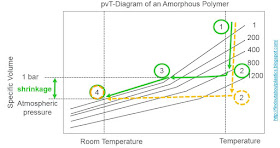 |
|
Digital welcome message
at the Lisbon airport.
|
Welcome to my blog series entitled Digital Plastics Revolution!
In our
daily lives we have noticed that digitalization and especially Industrial
Internet of Things (IIoT) initiatives are moving at a faster speed compared to
some years ago. At this speed more and more disruptions occur in all type of industries.
Digitalization is literally transforming one industry after the other. This
includes also the plastics industry.
In
this series I will explore and present the key elements of digital
transformation and how these can be used in the plastics industry. Each part of
this series presents a major key stone and is called therefore impactor.
So, let’s
get started with impactor 1:
Following
are my 5 ideas on how you can get the digital revolution started in your
plastics business:
1) Digital Technology Platforms (DTP’s): Nowadays,
new Digital Technology Platforms (DTP’s) constantly evolve. These are the major
building blocks to get your digital business alive. Gartner suggests that
companies should have a mix of 5 DTP’s [1]. These should be related to information
systems, customer experience, analytics and intelligence, the Internet of
Things and business ecosystems. In
addition, DTP’s allow your business partners to connect with you from any
location and device. Therefore, simply put: get familiar with DTP’s and learn
how they can be used in your business.
2) Start
creating digital ecosystems: We have to be fit to move in
more and more complex networks and interconnected systems. Keeping the
current hierarchical structured type of businesses will not help you dealing
with this kind of complexity, however, moving toward an ecosystem approach will.
Ecosystems are opened up systems and allow much more cross-functional
activities [2]. Our whole business leadership structure should change. Digital Leadership should be based on an above-hierarchy,
team concept which allows faster innovation. Bigger companies often re-structure
and re-organize to become “leaner”, but to the majority, the old hierarchal systems
are kept. This is often influenced by political interest of protecting individual
(high) positions within the business. Fact
is that the corporate culture and mindset needs to change!
3) Awareness of the New
Economy and its principles (winner-takes-it-all; zero-to-one with 10x improvements
[3]): Although
the internet is already 20 years old, the New Economy is still evolving and new
possibilities as well as challenges come along with it. In my opinion, awareness
of its main working principles is necessary for reforming and growing your
business. In a nutshell “the winner-takes-it-all”
meaning that the best and most used platform gets the monopoly of the market.
This principle was also coined by Peter Thiel with the expression zero-to-one [3].
Therefore, improvements in proprietary
technology should be in a scale of 10x so that new businesses may succeed. In
addition, based on a quote of Gary Vaynerchuck [4], you need to start asking
yourself every day in the morning: “How can I put myself out of business?” In
this way you challenge yourself to stay on top of your business. This is
especially true when your business is doing great, because then you tend to oversee the fact that
somewhere a little start-up is already working on your downfall.
4) Clear vison and self-awareness: Your
plastics business needs to agree on a vision which includes the digital
transformation. This comes along with transforming the whole company culture
including the employees’ mindsets. Everyone needs to lean in on their personal
side to avoid digital illiteracy. Your company and you need to live,
communicate and use methods from the year you’re actually living in (e.g. learning
how to use tools like Google trends to see when a trend starts to manifest).
5) Establish the role of
a Chief Digital Officer (CDO): We need CDOs in C-suites to push the
digitalization in plastics industry forward! This is also a clear sign to
address the importance of the ongoing changes. The Strategy& Chief Digital Officer
study [5] showed that only 6% of global companies (1,500 largest companies)
have established the position of a CDO. However, this number is rapidly
increasing. The consumer-focused industries have here the lead together with
large companies. Bottom line: suggest your CEO to hire a CDO or find motivated
people in your organization who can take up on such a position. This will help
speeding up things!
In impactor 2 of this Digital
Plastics Revolution Series I will present to you 2 major strategies to enhance
digital transformation in plastics industry!
Thanks for reading!
Till next time and
#findoutaboutplastics
Herwig
Literature:
[1] Kasey Panetta: Gartner’s
Top 10 Technology Trends, http://www.gartner.com/smarterwithgartner/gartners-top-10-technology-trends-2017/
[2] Pearl Zhu: Digital Master:
Debunk the Myths of Enterprise Digital Maturity (2015)
[3] Peter Thiel: Zero to One, Notes
on Startups, or How to Build the Future, Crown Business; 1 edition (September
16, 2014)
[5] Strategy&: The 2015 chief digital officer study, http://www.strategyand.pwc.com/reports/chief-digital-officer-study






